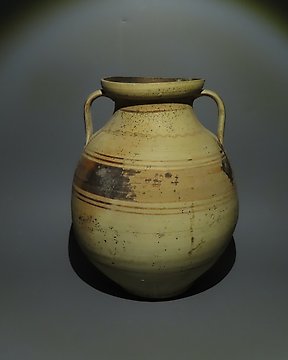
古希腊 陶器 佩利克。公元前 4 世纪。高 29 厘米
编号 82795485

编号 82795485

Female Head .
- VERY HUGE -
Ancient Greek, 4th century BC.
Pentelic marble
31 cm height without the stand.
Condition: There is volumetric loss at the back of the head, as well as erosion at the front of the head.
Provenance:
- Private collection, England, acquired before 2000. Acquired at a local auction from the contents of an estate.
- Private collection, UK, acquired from Godson & Coles in 2002.
- Forge & Lynch, London, 2017.
Female head carved in the round, originally belonging to a slightly larger than life-size sculpture. It represents a woman with an oval face, gently rounded cheeks and a prominent chin, a common model in the sculptures of goddesses in Greek classicism (fig. 1). The large, almond-shaped eyes are framed by thick eyelids that enhance their expressiveness through the play of chiaroscuro. The liveliness of the gaze would originally have been further enhanced by the polychrome work. The brow appears relaxed, although this area of the face is eroded. The same is true of the nose, which is now completely lost. On the other hand, the delicate work on the mouth, with full lips, closed in a slight, relaxed smile, can be appreciated.
The hair is simply combed, the wavy locks carved by deep incisions. It frames the face symmetrically, covering the upper part of the ears and being gathered at the nape of the neck, although there is a notable loss of material at the back of the head. These face-framing locks are arranged like a tiara, encircling the head and overlapping the rest of the hair. This is a type of hairstyle that can be found in other contemporary Greek works, especially in depictions of the goddesses Aphrodite and Hygieia (fig. 2) but also in portraits (fig. 3).
The head is slightly inclined with respect to the neck, which, together with the absent expression of the face and the type of hairstyle (fig. 4), allows us to relate the piece under study to the model of the Aphrodite of Cnidus, made by Praxiteles in Athens around 360 BC (fig. 5). This sculpture is the earliest known representation of the female nude in Greek statuary, and depicts Aphrodite surprised while bathing, gathering up her clothes and covering her pubis with her right hand. Other readings of the work speak of a symbolic meaning: the nudity refers to her divine birth in the sea, and the modest gesture would not indicate shame but would allude to fertility. In fact, the position of the right hand of the Cnidus Aphrodite can be directly related to the conventional gesture of the ancient Cretan representations of the goddess, works dating from the 7th century BC and close to the iconography of Astarte. In them, the gesture of covering the pubis with the hand is interpreted not as concealment but as an indication of the source of the goddess's power.
The Aphrodite of Cnidus was greatly admired in her time, even appearing on coins minted in the city of which she is named, and of which she became the patron saint. Her celebrity gave rise to a new form of depicting this goddess, an iconography known as Aphrodite pudica, which enjoyed great development during the Hellenistic period. It was also a hugely popular subject in Rome, with the Aphrodite of Cnidus being one of the most widely reproduced Greek works of the Roman period (fig. 6).
Hygia is considered to be the daughter of Asclepius and Lampecia, sister of Telesphorus, Iaso and Panacea, she was the goddess of healing, cleansing and healing.
Notes:
- The piece includes authenticity certificate.
- The piece includes Spanish Export License (Passport for European Union) - If the piece is destined outside the European Union a substitution of the export permit should be requested, can take between 1-2 weeks maximum.
- The seller guarantees that he acquired this piece according to all national and international laws related to the ownership of cultural property. Provenance statement seen by Catawiki.